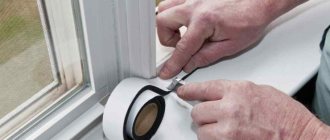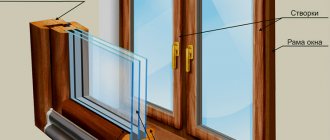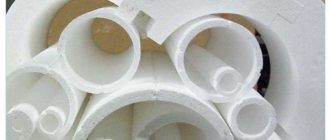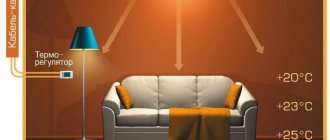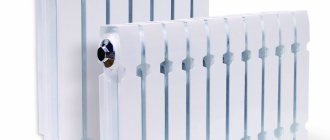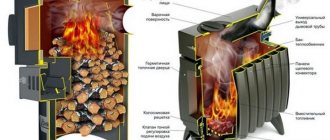Window paper
More precisely, paper putty.
This is the cheapest method, since all you need to seal the windows is a selection of old newspapers and water. To increase the effectiveness of the putty, you can add 2 parts of crushed chalk or 1 part of clay to it. The resulting mass is highly plastic, which makes it easy to seal even the smallest cracks. The window can be easily washed off the putty during operation (as long as it remains wet). Insulating windows with paper is an effective way, but only for one season; in addition, a covered window does not make it possible to open the sashes in winter. As the weather gets warmer, the putty is removed from the cracks and the window is washed. Cost : 0 rub.
Pros : free and simple.
Disadvantages : the need to repeat the work annually, there is no way to open a sealed window, it is not aesthetically pleasing and the presence of additional decor in the form of gluing paper or fabric strips.
Paper tape or fabric strip
The fastest way to eliminate a draft. You can’t count on significant insulation, but the work can be done quickly and at minimal cost.
Approximate price : 100-130 rubles/roll, strips of fabric (used material).
Advantages : cheap, high speed;
Disadvantages : minimal efficiency, tape peeling off in a draft.
How to seal windows with soap and paper (toilet) - video
Cotton wool or foam rubber for windows
Technical wool is cheaper, but it is sold in large quantities.
Using cotton wool or foam rubber, you can seal large gaps, for example, between window sashes or a sash and a wall or window sill. The cotton wool/foam rubber must be sealed on top with paper tape or special tape, because It is difficult to seal small cracks with cotton wool. In this case, the paper tape will serve not only a decorative function, but also increase the efficiency of insulation.
Average cost : cotton wool (50 rubles/200 g), foam rubber (30-35 rubles/skein).
Advantage : simplicity and lack of wet work.
Disadvantages : the cost of insulation increases (+ the price of cotton wool or foam rubber), additional finishing of the insulated seam is required. In addition: cotton wool and foam rubber absorb moisture, the work must be repeated annually, and a sealed window cannot be opened for ventilation.
How to cover windows with newspaper for the winter - video
How to apply vapor barrier tape to windows?
Replacing windows in a house is always accompanied by the installation of protection for the junction of the frame and the wall. Polyurethane foam is applied between the opening and the frame - traditional and proven thermal insulation. The foam performs its role properly, but if exposed to extreme moisture or ultraviolet radiation, its quality may change for the worse.
To eliminate the possibility of such a situation in advance and save yourself from replacing polyurethane foam in the future, you should think about sealing the seams. To do this, you need to install additional insulation.
A complete set of insulation allows you to avoid freezing of the room and minimize the penetration of moisture and noise.
The insulation between the wall and the window consists of three layers:
- Outer. Its function is waterproofing, which means protecting the room from any weather conditions - snow and rain.
- The load-bearing insulation layer is located in the middle of the joint and is responsible for heat and sound insulation. Protection from frost is provided by a porous material resembling polyurethane foam. The waterproofing agent prevents moisture from getting inside.
- The inner layer is also considered thermal insulation. Here the mechanism of heat conservation is different. This layer does not allow heat to escape from the inside, unlike the outer layer, which protects the premises from cold air flows from the street.
The vapor barrier of windows refers to the inner layer, but is not always included in the insulation system. Single-sided self-adhesive vapor barrier tape or double-sided vapor barrier tape is additional protection. The need to use tape increases if the window is installed in a room with a high moisture content: kitchen, sauna, bathhouse.
Installing vapor barrier tapes is no more difficult than installing other types of seam insulation. However, a vapor barrier can help avoid subsequent serious problems with the entire window protection system. When installing a vapor barrier, in some cases you may need a couple of additional accessories, for example, vapor barrier tape. This is worth considering.
Material selection
The choice of material should be based on the best characteristics for the given conditions. Each material has its own characteristics, which are taken into account when choosing it to cover a window. All materials differ in cost. This also needs to be taken into account.
Paper putty
Window paper is also called paper putty. It is one of the cheapest and simplest means. To prepare it, you only need paper, for example, newspaper, and water; to increase its effectiveness, you can add crushed chalk or clay to the resulting mass. This composition has high plasticity and is also easy to clean while it is wet.
The method is quite common due to its ease of preparation and minimal cost, as well as ease of removal. Insulated openings can only last one winter season. In addition, if you seal the windows with paper, the sealed windows cannot be opened. Paper putties are not used in harsh winter conditions, that is, if too much wind blows through the window, the seal will be compromised.
Paper tape
The fastest way to insulate windows is to use paper tape. It has a number of advantages, including low cost and speed of application, but it also has a number of disadvantages. In this way it will not be possible to reliably insulate window frames. In strong gusts of wind and drafts, the window tape will come off, and this also applies to severe frosts.
Window tape rarely lasts throughout the winter. A window pasted in this way must be covered with a special compound before preparation, then the effect will be better.
Cotton wool or foam rubber
Cotton wool or foam rubber is suitable for pasting. It is worth considering that special technical wool is sold only in large quantities. This method is ideal for sealing large gaps that form in the sashes, at the junction with a wall or window sill.
To get rid of small cracks, use adhesive tape. This will help to better insulate and also act as a decorative element. With this method, you need to spend money not only on basic, but also on auxiliary materials.
Types of insulating tapes and tape
Insulation sheets and tape have a number of advantages over other methods of window covering:
- The base will last for several years without replacement.
- Pasting is carried out independently, quickly.
- No additional materials are required.
- The adhesive base leaves no traces when peeled off and does not interact with the material to which it is glued.
But it is worth considering the disadvantages of this method:
- Covered openings cannot be opened.
- If the strip is poorly glued or of poor quality, then removal will be difficult and there will be tears.
There are two types of insulation sold in stores and markets:
- Pasting. This type has a lot of grip. Polyvinyl chloride, rubber raw materials, and foam rubber are used for its production. It has good flexibility and simply compresses to the required size. Stripes are available in black, white and brown colors. It is written on the packaging what size gap the fabric is suitable for.
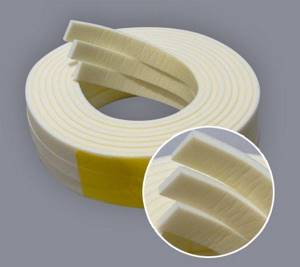
- Sealing. This type is characterized by a void inside the tube, which helps retain heat. One side is equipped with an adhesive layer. The 7 mm gap is tightly blocked and can withstand all temperature changes. The color of the strip is chosen to match the color of the glass unit.

The durability of the glued tape must be checked annually. If replacement is required, then do it for the entire strip or a separate fragment.
Window tape
Description
Window tape is a great way to reduce heat loss during cold weather. The width allows for reliable gluing of the strips to the frame even where there are fairly wide gaps between the frame sashes. The length of the tape in one roll is enough to cover several window structures.
Advantages:
- presence of an adhesive layer (no need to use additional adhesives)
- tensile strength;
- special impregnation of the paper prevents the passage of air.
The decision to buy such a tape significantly reduces your time and cost of preparing windows for winter.
Types of mounting tapes for windows
The functions performed by the tapes are different and depend on the location of gluing, the condition of the opening, the features of the future finishing of the slopes, as well as the requirements for the window block. Next, we will consider the most commonly used materials common in the modern construction market.
PSUL
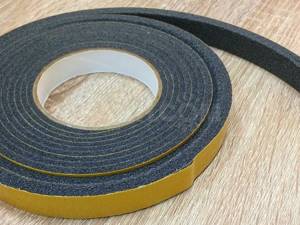
Pre-compressed sealing tape is used primarily on the outside of translucent structures. Its main purpose is to ensure unimpeded drainage of moisture from the area where the hatch connects to the opening.
Essentially, this is a tape product made of elastic polyurethane foam (looks like foam rubber), usually gray or black. One side of the material is covered with an adhesive composition, insulated with a protective film. The tape is supplied twisted into compact reels or rolls (depending on the size), which need to be unwound only during the installation process, since the material loses its quality over time.
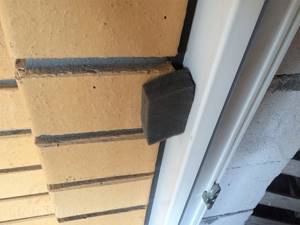
An example of tape expansion over time
The main feature is the ability to fill joints as a result of expansion, which occurs as a result of contact with air. The tape isolates the gap from moisture and external influences from the outside, while simultaneously allowing excess liquid to evaporate from the inside.
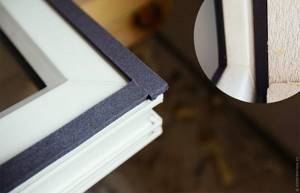
Scope of application of PSUL:
- Additional sealing of interfaces between elements of prefabricated structures;
- Sealing the gap between the frame and the opening when installing windows and doors;
- Insulation of joints between small-sized moving units of building facades;
- Filling the external seam between the slope and the frame during the installation of PVC windows.
It is important to understand that to fill the gap efficiently, you need a tape of the appropriate size. For example, if the task is to seal a joint with a maximum width of 40 mm, you will need a PSUL with a nominal size of 45-50 mm.
Water vapor barrier (GPL)
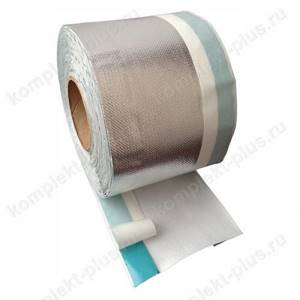
This type of tape product is most popular when installing window blocks. Among its main features it is worth highlighting the following:
- Water vapor barrier mounting tape is designed to seal joints on the room side.
- Polyethylene film is most often used as the basis for self-adhesive material. On one side the tape is equipped with a foil coating, and on the other - with an adhesive composition.
- The adhesive used provides reliable fixation on most surfaces (concrete, brick, cinder block, wood and others). The products of some brands have poor adhesion to foam blocks and aerated concrete, so before purchasing you should consult with the seller or read the attached instructions.
- The structure of the material prevents the penetration of moisture or air both through the tape itself and through the gluing points. This ensures the maximum possible tightness of the joint of the opening and, as a result, the structure as a whole.
- In addition to insulating from moisture, the tape does not deteriorate during prolonged contact with ultraviolet radiation and is not subject to destruction from exposure to aggressive environments (household acids, alkalis and other reagents).
The main tasks of window covering paper

Rice. 2. Insulating wooden windows with newspapers.
This insulation allows you to improve the performance characteristics of wooden frames. Its use does not cause any harm to frames and paint:
- there is no need to plug the cracks with foam rubber or newspapers soaked in water and rolled into bundles, which leads to distortions and only enlarges the cracks,
- there is no need to scrub off the black paint of old newspapers from the paintwork,
- in the spring there will be no need to tint the windows, since the old paint has come off along with the fabric or tape.
The next task that paper performs is to reduce noise coming from the streets. Along with improved sound insulation, the amount of dirt and dust coming from the streets is reduced. Work can be done using this material in any conditions. It is problematic to seal the windows at a time when it has become cold outside and the heating has not yet been turned on, since the condensation flowing down the glass will make the paste liquid and the rags may fall off. And black mold may appear on insulation, as well as on frames.
This method is suitable even for plastic windows on which the rubber seal has worn out.
Tips for choosing
To buy a quality tape, you need to focus on the following indicators:
- Material: foam rubber, PVC, rubber, PPE. Foam tape is the most affordable, flexible, and can close gaps of different sizes, but the porous structure quickly absorbs moisture, which leads to further deterioration of the raw material. PVC is stronger, resistant to moisture, and stretches. The rubber base can be self-adhesive or sealing tape. It contains rubber, which gives elasticity and resistance to temperatures. PPE is made from foamed polyethylene. Increased flexibility allows use for small window defects. Use at elevated temperatures is unacceptable, as a toxic compound will be released.
- Manufacturers. A lot of them. There are films from domestic representatives, and others from foreign ones. The most common ones can be identified: Profitrast, KIMTEC, Sanok. Domestic brands are not inferior in quality to foreign ones, as they are produced according to European standards and technologies.
- Price. The tape can be purchased by the meter or by the coil. Domestic materials are cheaper than foreign ones. So, Russian-made tape costs about 15 rubles per meter, and German quality tape costs 50 rubles.
Advantages of window covering paper
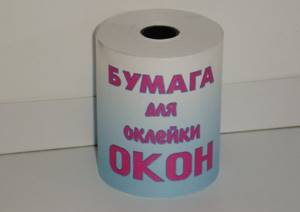
Rice. 3. Paper for covering windows.
The use of this type of insulation provides the following advantages.
- All materials used are environmentally friendly. Only wood-based substrate is used in paper production. Installation of non-gummed samples allows you to use a paste of your own production, which does not cause any harm. Glue of vegetable origin is also applied to gummed samples. Any other method carries a certain danger to the health of people living in the apartment. Foam rubber or other synthetic materials can emit toxic substances into the air; tape and its adhesive base are completely synthetic materials that, when destroyed, release carcinogens.
- This insulation does not have to be cut. It is sold in rolls of the required width. This saves a lot of time and makes sealed windows look neat, since uneven stripes of different widths can ruin the aesthetics of even the largest and shiniest window.
- Using this method does not pose a threat to the well-being of the family.
- This method will not require further steps for additional sealing.
- The attractive appearance of wooden frames is preserved. After opening the windows, the wood will need to be wiped with a damp cloth. There is no need to use solvents or spatulas that can disturb the paint or ruin the wood texture.
How to insulate wooden windows for the winter with your own hands
You can seal wooden frames with your own hands, using improvised or special materials. The easiest way to seal a window at home is with window putty or children's plasticine.
But, contrary to popular belief, folgoizol must be used with caution. The material is intended for use by professionals in industrial-scale construction
Using paper and rags
This method is the easiest and most economical. This is how our grandmothers used to cover their windows.
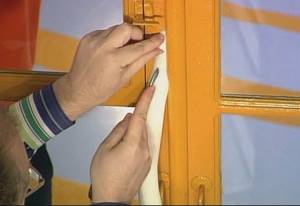
The process occurs in the following order.
- Paper products need to be cut into small pieces and rolled into rolls. Magazines, notebooks and any other paper will do.
- Soak the twisted rollers in a container of water. Use them to seal the holes between the base of the window and the sashes. It is convenient to fill holes using sharp objects.
- You can buy ready-made paper for pasting or make it yourself. It is necessary to cut sheets or rags into pieces about 5 cm wide. The prepared parts must be glued along the joints using paste or soap diluted with water.
Paste is made from flour or starch. Flour and water should be combined in equal parts. Cook over low heat until thickened, stirring frequently.
Starch paste is prepared as follows. 2 tablespoons of starch should be poured into water and stirred. Pour a glass of boiling water into the resulting mixture and cook.
Insulation with cotton wool, tape or adhesive tape
This is a modern way to increase the tightness of windows using improvised means. Instead of paper rollers - cotton wool, instead of pieces of paper and rags - adhesive tape or adhesive tape. When removing adhesive tape, paint sticks to it, so adhesive tape is preferable - it can be removed easily and neatly.
Foam tape with sticky backing
This option is convenient and effective. The tape is sold in most stores. Reliably insulates window structures.

Work must be carried out in the following order.
- Measure the length of the glued joints.
- Make an allowance for the width of the holes in order to buy thicker foam tape.
- Remove dirt and greasy components from the surface of the frame. You can use a solution of alcohol or acetone.
- Remove the protective layer from the tape and glue it to the joint.
Better sealing can be achieved by gluing a material with an adhesive base over the tape. Foam rubber can be used for several years, but paper must be removed and reapplied every season.
Disadvantages of window covering paper
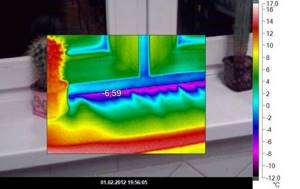
Rice. 4. Heat loss.
The main disadvantage of using special paper is the need to dismantle it with the onset of the spring-summer period. In any case, this must be done carefully. But the pure white material leaves no marks on the frames. There may be small traces of glue from gummed samples. But they can also be easily removed with a clean cloth moistened with water. You can use any household cleaner such as laundry detergent or detergent. The main thing is that it does not contain strong aggressive chemical components such as chlorine. Such substances can dissolve even a thick layer of oil paint, making it sticky and collecting dirt and dust on its surface. Removing the adhesive backing on plastic frames using strong detergents can change the color and texture of the plastic, making it porous and yellowish.
Another disadvantage is the possibility of the strips falling behind the frames if the gaps are too large and the winds are too strong. In this case, you will have to eliminate the gaps before pasting by plugging them with cotton wool.
Scotch tape for window insulation
Scotch tape is a name for painting tapes with a different base, on which an adhesive layer of natural or artificial rubber is applied. The base can be paper (crepe) or PVC. There are other varieties, but they are not suitable for covering windows.
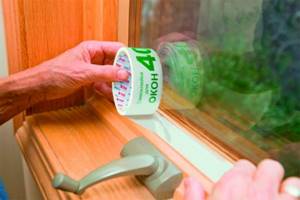
Crepe paper differs from regular paper in that it has a corrugated surface. This gives it additional moisture-retaining properties.
Correct installation of window covering paper
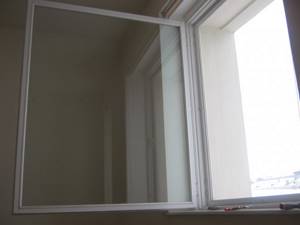
Rice. 5. Installation of paper for covering windows.
Before starting insulation, the window must be prepared. It needs to be cleaned well. If there are elements of old insulation left on the frames, it will have to be removed. The frames will need to be unscrewed and the glass washed. After this it needs to be dried. Pasting wood that has not dried out will make the insulation vulnerable to strong winds, as it will not allow the paste to dry properly.
Rolls of adhesive material must be printed. It is necessary to adjust the length of the strips by measuring along the gap.
Well-washed wooden elements to be covered can be additionally degreased. This will allow the paste to “grasp” the frame more tightly. Degreasing can be done with regular vodka. Its strength will be quite enough. You should not use solvents for degreasing, as they can damage the varnish or paint.
Gummed strips need to be moistened, and non-gummed strips need to be coated with glue. Let them absorb the glue a little and then close the cracks with them.
Covering windows with paper strips
As soon as it gets cold outside, we remember that it’s time to insulate the house. It is best, of course, to install plastic windows that close hermetically and do not allow drafts to pass through. But, if replacement is not included in your plans for the next month, then you need to start sealing them.

One of the simplest and most reliable methods is to use paper strips to cover the joints between the glass and frames. Of course, they don’t provide any warmth, but they will protect you from cold air.
Another advantage of paper window insulation is the speed of work. It will take you less than an hour to cover all the windows in your apartment.
The work sequence looks like this:
- Buy paper strips. This can be done at any construction or hardware store for a very reasonable price. If you have a lot of white paper at home, you can make them yourself. Then the insulation will take place without any costs.
Some people recommend using toilet paper for this purpose, but we do not recommend this. To begin with, such windows do not look aesthetically pleasing at all.
Toilet paper becomes limp and tears very easily, so at the slightest dampness, you risk being left without protection.
- Prepare the adhesive. You can use wallpaper glue, just dilute it in a lower concentration to make the paper easier to remove in the spring. Another option is flour brewed with water. This is exactly the recipe our grandmothers used.
And if you simply don’t have time for such manipulations, use soap that is soaked in water and rubbed over a strip.
- Keep the frames free of dirt and dust, as this can interfere with the bond and the paper will soon come loose.
- Apply glue to the paper and attach it to the desired location. Make sure that it completely covers the space and is evenly distributed on both sides. This must be done quickly so that the strips do not have time to soften and tear.

That's it, job done. After a few days, the paper will dry and become harder. With this simple and quick method, you can keep your home warm throughout the winter.
Insulation with sealing tape
Typically, plastic windows lose heat for two reasons:
- breakdown of fittings;
- seal wear.
Correct installation of the tape increases the insulating ability of the window. The following sequence of work is recommended:
before installation, the tape is kept at a positive temperature, since this affects its expansion inside the groove;
The tape is cut to fit the window. The joints are cut at right angles. For thermal expansion, a reserve is created: for every meter 1 centimeter of material;
The tape is pressed into the groove with a spatula, and the adhesive strips are removed in small sections.
Important!
1. In the corners of the frame, the tape is connected only end-to-end.
2. To prevent impregnation from leaking out, the tape is not compressed more than the permissible value.
After installing the sealing tape, the locking mechanism is adjusted: the pressure is changed by trunnions, which are located at the end of the sash.
Adjustment is made with a hex wrench. The pressure increases when the trunnion head is installed in a horizontal position.
The Swedish method of insulating such windows using EuroStrip technology is in great demand. It has the following advantages:
there is no need for annual window insulation;
after ventilation, the tightness of the windows is not compromised;
frame service life increases;
high degree of protection from dust and street noise.
For insulation, two types of tapes are used: rubber and silicone.
By the way, branded Swedish silicone seals are easily inserted into the groove and last up to 20 years.
Installation is performed in the following sequence:
the sashes are removed from their hinges and inspected. Rotten areas are identified and then restored;
a groove is cut along the entire sash for the tape;
using a roller, the tape is pressed into the groove;
A rubber cord is placed inside the frame, and then the sashes are pulled together;
The window is hung on hinges and adjustable. If necessary, the hinges are rearranged and the fittings are changed.
So, both types of window insulation tapes deserve attention. Which one is better depends on the condition of the window.
If you choose the right one, the insulation will quickly pay for itself, and the apartment will always be warm and cozy.
Method for gluing windows with newspapers
Another original option for insulating your home is using old newspapers. Almost every apartment has a lot of newspapers and magazines that no one needs anymore. So why not reuse them. This way you will get rid of junk, keep the house warm, and save your family budget.

Of course, as in the previous case, before insulating the window with newspapers, you need to wash it thoroughly and allow it to dry. At this time, you can safely take out the newspapers and prepare them for further processing.


